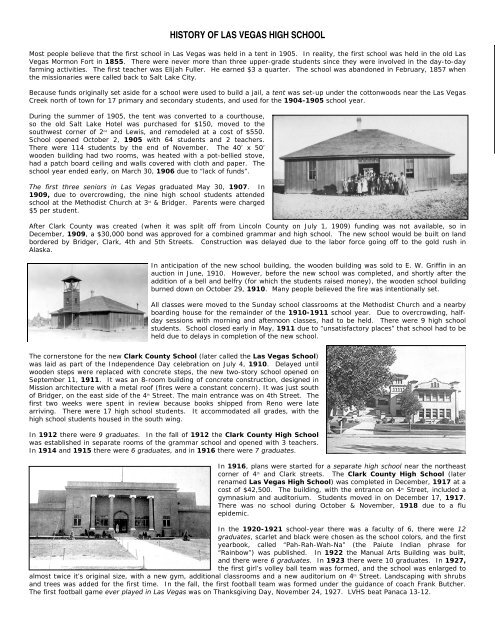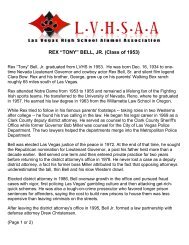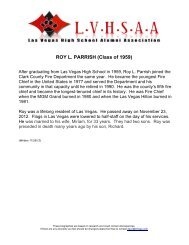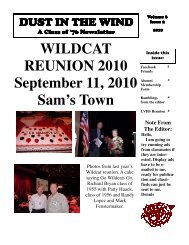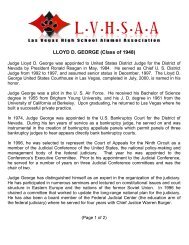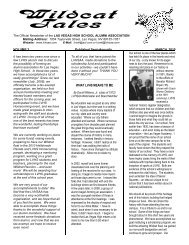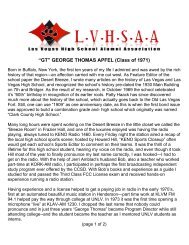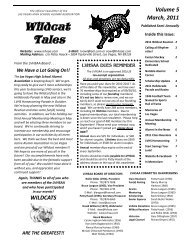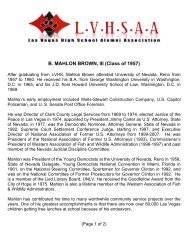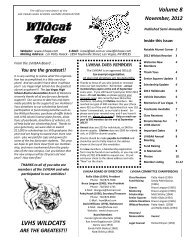LVHSAA-Las Vegas High School Alumni Association
LVHSAA-Las Vegas High School Alumni Association
LVHSAA-Las Vegas High School Alumni Association
Create successful ePaper yourself
Turn your PDF publications into a flip-book with our unique Google optimized e-Paper software.
HISTORY OF LAS VEGAS HIGH SCHOOLMost people believe that the first school in <strong>Las</strong> <strong>Vegas</strong> was held in a tent in 1905. In reality, the first school was held in the old <strong>Las</strong><strong>Vegas</strong> Mormon Fort in 1855. There were never more than three upper-grade students since they were involved in the day-to-dayfarming activities. The first teacher was Elijah Fuller. He earned $3 a quarter. The school was abandoned in February, 1857 whenthe missionaries were called back to Salt Lake City.Because funds originally set aside for a school were used to build a jail, a tent was set-up under the cottonwoods near the <strong>Las</strong> <strong>Vegas</strong>Creek north of town for 17 primary and secondary students, and used for the 1904-1905 school year.During the summer of 1905, the tent was converted to a courthouse,so the old Salt Lake Hotel was purchased for $150, moved to thesouthwest corner of 2 nd and Lewis, and remodeled at a cost of $550.<strong>School</strong> opened October 2, 1905 with 64 students and 2 teachers.There were 114 students by the end of November. The 40’ x 50’wooden building had two rooms, was heated with a pot-bellied stove,had a patch board ceiling and walls covered with cloth and paper. Theschool year ended early, on March 30, 1906 due to “lack of funds”.The first three seniors in <strong>Las</strong> <strong>Vegas</strong> graduated May 30, 1907. In1909, due to overcrowding, the nine high school students attendedschool at the Methodist Church at 3 rd & Bridger. Parents were charged$5 per student.After Clark County was created (when it was split off from Lincoln County on July 1, 1909) funding was not available, so inDecember, 1909, a $30,000 bond was approved for a combined grammar and high school. The new school would be built on landbordered by Bridger, Clark, 4th and 5th Streets. Construction was delayed due to the labor force going off to the gold rush inAlaska.In anticipation of the new school building, the wooden building was sold to E. W. Griffin in anauction in June, 1910. However, before the new school was completed, and shortly after theaddition of a bell and belfry (for which the students raised money), the wooden school buildingburned down on October 29, 1910. Many people believed the fire was intentionally set.All classes were moved to the Sunday school classrooms at the Methodist Church and a nearbyboarding house for the remainder of the 1910-1911 school year. Due to overcrowding, halfdaysessions with morning and afternoon classes, had to be held. There were 9 high schoolstudents. <strong>School</strong> closed early in May, 1911 due to “unsatisfactory places” that school had to beheld due to delays in completion of the new school.The cornerstone for the new Clark County <strong>School</strong> (later called the <strong>Las</strong> <strong>Vegas</strong> <strong>School</strong>)was laid as part of the Independence Day celebration on July 4, 1910. Delayed untilwooden steps were replaced with concrete steps, the new two-story school opened onSeptember 11, 1911. It was an 8-room building of concrete construction, designed inMission architecture with a metal roof (fires were a constant concern). It was just southof Bridger, on the east side of the 4 th Street. The main entrance was on 4th Street. Thefirst two weeks were spent in review because books shipped from Reno were latearriving. There were 17 high school students. It accommodated all grades, with thehigh school students housed in the south wing.In 1912 there were 9 graduates. In the fall of 1912 the Clark County <strong>High</strong> <strong>School</strong>was established in separate rooms of the grammar school and opened with 3 teachers.In 1914 and 1915 there were 6 graduates, and in 1916 there were 7 graduates.In 1916, plans were started for a separate high school near the northeastcorner of 4 th and Clark streets. The Clark County <strong>High</strong> <strong>School</strong> (laterrenamed <strong>Las</strong> <strong>Vegas</strong> <strong>High</strong> <strong>School</strong>) was completed in December, 1917 at acost of $42,500. The building, with the entrance on 4 th Street, included agymnasium and auditorium. Students moved in on December 17, 1917.There was no school during October & November, 1918 due to a fluepidemic.In the 1920-1921 school-year there was a faculty of 6, there were 12graduates, scarlet and black were chosen as the school colors, and the firstyearbook, called “Pah-Rah-Wah-Na” (the Paiute Indian phrase for“Rainbow”) was published. In 1922 the Manual Arts Building was built,and there were 6 graduates. In 1923 there were 10 graduates. In 1927,the first girl’s volley ball team was formed, and the school was enlarged toalmost twice it’s original size, with a new gym, additional classrooms and a new auditorium on 4 th Street. Landscaping with shrubsand trees was added for the first time. In the fall, the first football team was formed under the guidance of coach Frank Butcher.The first football game ever played in <strong>Las</strong> <strong>Vegas</strong> was on Thanksgiving Day, November 24, 1927. LVHS beat Panaca 13-12.
In 1928, with the start of construction of Boulder Dam, the name of the yearbook was changed to “Boulder Echo” and a $5 awardwas given to the student that named it. There were 24 graduates. Plans were started for a new high school, designed for a studentbody capacity of 500, at 7 th and Bridger. Many resisted, saying it would be “too far out of town” and would never be filled! Therewere 29 graduates in 1929, and 32 in 1930 - the largest class in the history of <strong>Las</strong> <strong>Vegas</strong>.Laying of thecornerstone04/11/30The new <strong>Las</strong> <strong>Vegas</strong> <strong>High</strong> <strong>School</strong> at 7 th & Bridger, built at a cost of $350,000 in the ArtDeco style, opened in the fall of 1930 and was dedicated on November 2. The originalhigh school on 4 th Street became part of the grammar school. That year the Honor Clubwas formed, the Desert Breeze newspaper was started, and Frank Butcher, Head ofAthletics, died in a gasoline fire at the age of 26. In 1931, Butcher Field was named inhis honor and the Boulder Echo was dedicated to him. In 1932, 15 issues of theDesert Breeze were published, and there were 75 graduates.The Great Depression swept across the country and theunemployed converged on <strong>Las</strong> <strong>Vegas</strong> hoping for jobs onthe Boulder Dam project. In 1933, Boulder Citybecame a reality and 165 high school students werebused to <strong>Las</strong> <strong>Vegas</strong>. LVHS enrollment jumped to 473students and the “Wildcat” mascot was born. Therewere 100 graduates in 1934, and the Desert Breeze was expanded to two pages.On May 24, 1934, the original <strong>Las</strong> <strong>Vegas</strong> <strong>High</strong> <strong>School</strong>, whichhad become part of the <strong>Las</strong> <strong>Vegas</strong> Grammar <strong>School</strong>, burneddown. Wooden buildings with slanted tent-type canvas roofsand no windows, built on “skids” so they could be pulled intoplace, were placed just north of the burned-out school andused for the 6 th, 7 th & 8 th grades in 1934 and 1935 until thenew 5 th Street <strong>School</strong> was opened in 1936.In 1935 there were 775 students enrolled in <strong>Las</strong> <strong>Vegas</strong> <strong>High</strong> (in the school built for 500), andin 1936 there were 69 graduates. In 1937, there were 91 graduates and Bill Nellisgraduated. He was shot down over Luxembourg 4 years later and was memorialized by the naming of Nellis Air Force Base.Dougan’s Café (on the northwest corner of 7 th and Bridger, later known as the “Kick-Off”) openedand became a favorite gathering place for students in 1941.In 1943 yearbook photos were taken in groups toconserve paper during the war years, and 1944 sawthe first decline in school enrollment due to the draftand enlistments. There were 107 graduates in 1945.In 1946, Maude Frazier retired after 19 years ofservice, the Annex Building and band room wereadded, Walter V. Long became Vice Principal, and theWildcat Lair was established at 4 th and Stewart. In1947 construction was started on Frazier Hall, the <strong>School</strong> Administration Building wasadded, Evelyn Stuckey formed the Pep Cat Drill Team and the marching band wasorganized. In 1949 Frazier Hall was completed, bleachers were added to Butcher Field,the Boulder Echo was renamed “Wildcat Echo” (because Boulder Dam was renamed Hoover Dam that same year). The Rhythmetteswere formed, and over 1000 students were enrolled.The first performance of the Rhythmettes was held in 1950. The senior boys formed the“Figuerettes”, and the first Rhythmette Revue was presented in 1951. In 1952, theRhythmettes performed at the Hollywood Bowl, 200 girls tried out for 6 Rhythmetteopenings, bond issues were launched for a new auditorium and additional vocationalshop space, and there were 228 graduates. In 1954, Butcher Field was enlarged, thenew auditorium opened on the corner of 9 th & Clark, there were 1820 students enrolled(in a school then built for 1500) and there were 283 graduates. In 1955 there wereover 1900 students enrolled, there were 387 graduates, and the Wildcat Lair closed. In1956 the University of Nevada, Southern Division, shared space at LVHS, and therewere 403 graduates, the largest graduating class in LVHS history and the last graduatingclass in <strong>Las</strong> <strong>Vegas</strong> where all seniors were in only one high school. Rancho <strong>High</strong> <strong>School</strong>opened in 1953, and Gorman <strong>High</strong> <strong>School</strong> opened in 1954; however, neither had Seniors until 1957. The Sir Herkimer Bonetradition for the annual football game with rival Rancho <strong>High</strong> started in 1957.In 1960 the Rhythmettes and LVHS Band appeared in the half-time production at a Ram’s game in the Los Angeles Coliseum. Thatyear also saw the last Freshman class at LVHS (the class of 1963) when Junior <strong>High</strong> <strong>School</strong>s came into existence. By 1961,everything at LVHS was getting bigger – including the Wildcat Echo and the Desert Breeze. Post Hall, named after Dennis JamesPost, a student that died of cancer in 1959, was opened. The Student Senate increased to 55 members and they continued thetradition of providing Thanksgiving baskets for needy families. In 1964, the Rhythmettes went to the Big Apple to represent Nevadaat the New York World’s Fair. In 1966, Principal Walter V. Long retired after 28 years at LVHS, along with long-time teachers JosephThiriot, Eldon Larson, Gwendolyn Woolley and Warren Portenier. The Rhythmettes were disbanded in 1967 due to Evelyn Stuckey’shealth. In 1968 the student body adopted a foster child, hoping the program would become a tradition. The same year Soccer wasintroduced for the first time and many grads were bound to Vietnam. In 1969 the band took honors at the California Music Festivaland the Student Body sponsored a Vietnamese orphan.
In 1970 the Desert Breeze acquired a new headline machine and for the first time, subscriptions were sold (for $1.50). EvelynStuckey’s Flag Twirlers began in 1971, the new Student Union building opened, and the football team was the smallest and lightest,but beat Western for the first time! In 1972 more and more boys had long hair. In 1973 long, straight hair became vogue for thegirls along with long floor-sweeping “granny dress” skirts, and the Flag Twirlers became the new Rhythmettes, once again led byEvelyn Stuckey. In 1976, LVHS was budgeted for 2500 students, Freshman were back for the first time since 1960, and a newgroup called Spectrum appeared on the campus. Sir Herk’s bone was returned to LVHS in 1977 after 4 years. Coach and AssistantPrincipal Harry Paille retired in 1979 after 30 years at LVHS, and the girl’s basketball team won the first State Championship in LVHShistory. By the 1979-1980 school year, LVHS was the smallest public high school in <strong>Las</strong> <strong>Vegas</strong>, with only 1200 students enrolled.Population had moved to suburban areas and downtown was rapidly becoming mostly commercial.Rhythmette founder Evelyn Stuckey died in April of 1980. In 1981, the Wildcats kept Sir Herk’s bone for the 5th straight year. In1982 the Gymnastics Team was formed and performed at football and basketball halftimes. In 1986, the main building andgymnasium were placed on the National Register of Historic Places, and in 1987, Governor Richard Bryan (LVHS Class of 1955)signed a bill preserving LVHS as an historic landmark. In 1988 the auditorium was renovated, and the Men’s Bowling Team wasranked #1 in the nation. In 1991, the surrounding neighborhood, bordered by Bridger to Gass and 6th to 9th Streets, was alsoplaced on the National Register of Historic Places. In 1992, the LVHS marching band performed at an UNLV rally for Presidentialcandidate Bill Clinton in October. Many students were already being bused in from the East, so they were rezoned to a new school,designated as Winchester <strong>High</strong> <strong>School</strong>, being built at East Sahara and Hollywood, near Sunrise Mountain. It was renamed “<strong>Las</strong><strong>Vegas</strong> <strong>High</strong> <strong>School</strong>”, carrying on their image of excellence, pride and commitment, and embracing the historic legacy that is <strong>Las</strong><strong>Vegas</strong> <strong>High</strong> <strong>School</strong>. Our “old” <strong>Las</strong> <strong>Vegas</strong> <strong>High</strong> <strong>School</strong> became the “<strong>Las</strong> <strong>Vegas</strong> Academy of International Studies, Performing & VisualArts” in the fall of 1993. The LVHS class of 1993 was the last class to graduate from the 7 th Street campus.A NEW ERA BEGINS . . . .In the fall of 1993, the new <strong>Las</strong> <strong>Vegas</strong> <strong>High</strong> <strong>School</strong> opened at 6500 E. Sahara. The class of 1994 was the first graduating class atthe new campus, with 307 graduates.The new campus on East Sahara is close to 10 miles from the 7th Street campus, compared to the previous jump of a few blocks.The new location at the eastern edge of Sahara Avenue mirrored the extreme growth of the <strong>Las</strong> <strong>Vegas</strong> Valley. The previous site is ingood hands as it continues to serve high school students as a public, magnet high school dedicated to the performing and visual arts.Symbols of tradition, including the Wildcat mascot, Sir Herkimer’s Bone, and the school colors of red and black have now guided anew generation forward. Athletic achievements and records that were destined to never be matched have now been expanded upon.Written in 2013 by Patty Haack, Class of 1956, with help from <strong>LVHSAA</strong> Historian Joe Thomson. Sources: <strong>Las</strong> <strong>Vegas</strong> Age Newspapers 1910-1917, <strong>Las</strong> <strong>Vegas</strong> <strong>High</strong> <strong>School</strong> -Its People - Its Impact, published in 1992, a compilation of articles in the <strong>Las</strong> <strong>Vegas</strong> Sun Magazine from April-November, 1980, Chapter Seven of “Young <strong>Las</strong> <strong>Vegas</strong>, 1905-1931” published in the <strong>Las</strong> <strong>Vegas</strong> Review Journal on April 10, 2005, LVHS yearbooks, “Education in the Neon Shadow” by the Clark County <strong>School</strong> District and interviewswith numerous LVHS alumni.


